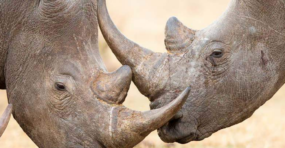Posted on 27 May 2020
Since the start of 2020, we have seen some important changes in China’s wildlife trade policy. Although some represent significant new restrictions on commercial wildlife trade, much trade in threatened wildlife appears to continue unaffected.
While we don’t know exactly how SARS-CoV-2 first crossed species barriers to infect humans, the suggested link between the virus and wildlife trade has prompted a succession of policy changes or revisions in China, with implications set to far outlast the current crisis.
Some recent changes potentially signal a significant shift in government approaches to wildlife trade, whereas others, conversely, indicate intransigent support from elements of officialdom for the use of wild animals in, for instance, traditional Chinese medicine. Yet imminent revision to the country’s Wildlife Protection Law presents an opportunity for lawmakers to cement a newly precautionary approach to wildlife trade, and set China apart as a leader in conservation.
Of course, all governments must address serious concerns about the role of official policies – and/or ineffective enforcement – in perpetuating exploitation of wildlife that poses a risk to biodiversity or human health. This issue is far from limited to China, and must be addressed as part of a global shift away from a destructive and consumptive relationship with the natural world. Nevertheless, as a major source of demand for trafficked wildlife – from pangolins to rosewood – China’s official policies and their impact on demand for threatened wildlife are of global importance.
To understand what has changed in 2020, we need first to understand what the policy had been. The Wildlife Protection Law of the People’s Republic of China is the country’s foremost piece of legislation covering conservation of and trade in wild animal species (more precisely translated as the Wild Animal Protection Law, the legislation does not cover plants). The law has long been controversial, in that it endorses so-called ‘utilization’ of wildlife, as well as its protection. The key operative language on hunting, breeding, trade and consumption is mostly concerned with protected species. On trade in non-protected species, the law at present simply states that proof of legal origin, such as a hunting or import permit, is required.
Mechanisms for the commercial breeding of and trade in even protected species are written into the law, which states that where ‘necessary for scientific research, captive breeding, public exhibition or performances, heritage conservation or other special purposes’, trade in and use of protected species may be permitted. The Environmental Investigation Agency (EIA) has documented how, in practice, these ‘special purposes’ are interpreted to cover commercial trade in wild-sourced specimens of species subject to the highest levels of protection, such as leopards, for the purposes of traditional medicine.
The first major change in wildlife trade policy after the emergence of COVID-19 in late 2019 came about on 26 January 2020, when three agencies jointly issued the ‘Notification regarding prohibition of trade in wildlife’. This document states that, ‘until the epidemic situation is resolved nationwide … all business operations including agricultural produce markets, supermarkets, food and beverage sellers and online sales platforms shall strictly prohibit trade of wild animals in any form’.
Despite the ostensibly all-encompassing language of this (albeit temporary) ban on trade in wild animals, it was not entirely clear which forms of wildlife trade were covered. What about auction of ivory artefacts, for example? Or pharmacy sales of processed medicines containing wild animal ingredients?
Then, on 24 February 2020, a set of ‘Decisions’ adopted by the Standing Committee of the National People’s Congress (NPC), China’s highest law-making body, banned the commercial breeding and trade in (almost) all terrestrial wild animal species, not just protected species: in doing so going further than the Wildlife Protection Law. If implemented effectively and ethically, this could be good news for many species threatened by consumption as food. Moreover, it suggests that some elements of government are prepared to take a far more precautionary approach to wildlife trade in recognition of the potential risks posed to biodiversity and human health.
However, the February Decisions only addressed consumption as food. This means that breeding and trade for purposes such as pets, ornamental items and traditional medicine were not covered. As such, the provisions of the Wildlife Protection Law – under which legal trade in pangolin scales, leopard bone and skins of captive-bred tigers is permitted – continue to apply for trade for non-food purposes. The February ban moreover only applies to ‘terrestrial’ wild animal species, meaning farming and trade in aquatic wild animal species as food, such as turtles, frogs and the critically endangered Chinese giant salamander, appear to be unaffected.
The February Decisions also referred to a list of species of which captive populations may be managed as livestock, thereby subject to regulations around livestock husbandry and exempt from the prohibition on breeding and trade. The Ministry of Agriculture and Rural Affairs issued a draft of this list on 8 April 2020. Chinese NGOs have expressed concern that the inclusion of species such as mallard and ring-necked pheasant could complicate law enforcement and enable laundering of wild-caught animals, while many groups have opposed the inclusion of species bred for their fur, such as mink and foxes.
Significant questions remained on release of the February Decisions: what would happen to live animals held in captive facilities, and how would their welfare be considered? How would the government manage compensation and retraining for people who had invested in what had been legal wildlife breeding, with official encouragement? And if the aim of the new policy was to minimize risks posed to public health by farming and trade of wildlife, does a failure to address non-food purposes not undermine this objective?
Subsequent policy documents indicated that, in some areas of government at least, support remains for use of threatened wild animal species in traditional medicine. An injection that contains the bile of farmed bears was included in a list of recommended treatments for COVID-19 issued by the National Health Commission and the National Administration of Traditional Chinese Medicine on 3 March. A document published by the National Forestry and Grasslands Administration on 8 April, laying out options for dealing with wild animals which had been bred legally for trade as food, includes suggestions that breeders should shift towards supplying traditional medicine if the species has ‘medicinal value’. Draft guidance issued by the National Intellectual Property Administration on 8 April states that while patents should not be issued for products containing tiger bone and rhino horn, patents that use ‘rare medicinal ingredients’, which are not prohibited by the law (a category that would include leopard bones, pangolin scales, saiga antelope horn and musk), may be granted.
A different approach seems to be reflected in another draft guidance document published by the National Healthcare Security Administration on 28 April. This document specifies that medicines containing ‘nationally rare or endangered wild animal or plant ingredients’ will not be covered under basic medical insurance. Although only a draft at present, this provision indicates that support for use of threatened wildlife in traditional medicine is not consistent across all levels of government.
Many wildlife advocates in China have long been calling for a shift in wildlife policy to permanently end the commercial use of threatened species. Since the renewed focus on health risks related to trade and consumption of wildlife, many experts in China have urged lawmakers to adopt a far more precautionary approach to wildlife trade. Academics and NGOs have specifically called for the prohibition on trade in wild animals as food to be extended to traditional medicine.
A revision of the Wildlife Protection Law – already underway – presents lawmakers with a narrow window of opportunity to heed such calls and enshrine in legislation a prohibition on all trade in threatened wild animals. Some lawmakers have publicly stated their positions for the revision. Some, such as Lin Tengjiao, have specifically called for an end to farming of wild animals for production of traditional medicines. Others, like Zhang Boli, want exemptions for traditional medicine to be maintained, while Li Xia has been more explicit in supporting continued commercial farming of wildlife.
A revised draft of the law is currently anticipated in the second half of 2020. At this juncture, China’s lawmakers could consolidate the commendable precautionary approach to wildlife trade represented in the February Decisions by amending the law to prohibit commercial trade in threatened wild animals for any purposes. This would further ensure that China’s future wildlife trade policy is coherent and consistent in addressing the potential threats posed by trade in wild animals to biodiversity and public health, and set the stage for a more successful meeting of the Convention on Biological Diversity (originally scheduled for October 2020 in China, now postponed) with a much needed example of ambitious policy change.
Cover: A permit and a tiger skin rug in Xiafeng taxidermy with, inset, permit details (c) EIAimage



